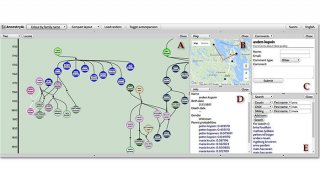
Aalto University doctoral student Eric Malmi has developed a family tree algorithm called AncestryAI. The algorithm looks for links between 5 million baptisms from the end of the 17th to the mid-19th century and partly to the beginning of the 20th century. To investigate your own family roots, you need to know about your own ancestors, because baptisms in the last hundred years are not public information.
‘The data is derived from parish registers. In the HisKi project, organized by the Genealogical Society of Finland, volunteer genealogists are entering information from registers into a database. Besides baptisms, the data includes marriages, burials and moves, although the algorithm is not yet taking advantage of this information. There are gaps in the material, for example because of churches burning down, but nevertheless, it is unusually comprehensive on an international level, including information for several centuries,’ said Malmi.
The family tree algorithm automatically searches for a child's most probable parents and creates family trees based on this. The algorithm gives several options based on the parents’ date and place of birth and similar names. The algorithm takes about half an hour to link all the records in the data.
‘The search path can also be used to find out whether two people are related to each other. Many people might be interested to know, for example, whether they are related to the great Finnish author Aleksis Kivi or other famous historical figures. Nevertheless, we need to consider the fact that if the path is long and all the links are uncertain, it is very unlikely that the whole path is correct,’ Malmi pointed out.
AncestryAI users can leave comments on the accuracy of the algorithm in inferring relationships. Using the comments, the algorithm can be trained to determine the relationships more accurately, and comments are displayed for other users.
‘It would be really interesting to have a family tree covering the whole of Finland, because it could also be used to study wars, epidemics, the influence of and changes in the class society. This is not possible yet, because, for example, the algorithm does not make use of communion books. So the algorithm is not intended to replace the work of genealogists, but to help them by speeding up their work, and somewhat improving the accuracy of their results,’ Malmi concluded.
Malmi is presenting AncestryAI at the Suku 2017 event in Otaniemi on 19 March 2017. At the beginning of April, Malmi is presenting the algorithm’s technical features at the World Wide Web Conference in Australia. AncestryAI can be accessed at http://ancestryai.cs.hut.fi/ and will run in a Chrome or Firefox browser. AncestryAI is part of Malmi’s doctoral thesis studies.
Further information:
Eric Malmi
Doctoral Candidate
Aalto University Department of Computer Science
[email protected]
www.genealogia.fi
hiski.genealogia.fi
Contact person: Eric Malmi
Last updated on 17 Mar 2017 by Noora Suominen de Rios - Page created on 17 Mar 2017 by Noora Suominen de Rios